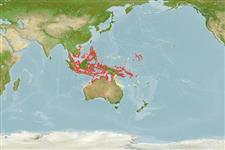>
Eupercaria/misc (Various families in series Eupercaria) >
Labridae (Wrasses)
Etymology: Diproctacanthus: Greek, di = two + Greek, proktos = anus + Greek, akantha = thorn (Ref. 45335).
More on author: Bleeker.
Environment: milieu / climate zone / depth range / distribution range
Écologie
marin récifal; profondeur 2 - 25 m (Ref. 90102), usually 2 - 20 m (Ref. 27115). Tropical; 24°C - 28°C (Ref. 27115); 19°N - 25°S, 99°E - 172°E
Western Central Pacific: Philippines, Palau, Indonesia, New Guinea, and Great Barrier Reef.
Taille / Poids / Âge
Maturity: Lm ? range ? - ? cm
Max length : 10.0 cm TL mâle / non sexé; (Ref. 6023)
Épines dorsales (Total): 9; Rayons mous dorsaux (Total): 9-10; Épines anales 2; Rayons mous anaux: 9 - 11; Vertèbres: 25. Juveniles with 3 broad black stripes from head to caudal fin where the stripes merge; with growth, lower stripe disappears, upper stripe is less distinct; black caudal fin becomes entirely yellow in adults. Head scales small. Lips thick and fleshy, forming a short tube when mouth is closed. Caudal fin rounded to truncate; pelvic fins rounded.
A solitary species (Ref. 90102) occurring in coral rich areas of shallow lagoons and sheltered seaward reefs. Adults feed mainly on coral polyps while juveniles remove ectoparasites from small territorial fishes (Ref. 2334, 9710). Adults swim in small groups. Usually, only small juveniles clean other fishes (Ref. 48636).
Life cycle and mating behavior
Maturité | Reproduction | Frai | Œufs | Fécondité | Larves
Oviparous, distinct pairing during breeding (Ref. 205).
Randall, J.E., G.R. Allen and R.C. Steene, 1990. Fishes of the Great Barrier Reef and Coral Sea. University of Hawaii Press, Honolulu, Hawaii. 506 p. (Ref. 2334)
Statut dans la liste rouge de l'IUCN (Ref. 130435)
Menace pour l'homme
Harmless
Utilisations par l'homme
Aquarium: Commercial
Plus d'informations
RéférencesAquacultureProfil d'aquacultureSouchesGénétiqueElectrophoresesHéritabilitéPathologiesTraitementNutrientsMass conversion
CollaborateursImagesStamps, Coins Misc.SonsCiguateraVitesseType de nageSurface branchialeOtolithesCerveauxVision
Outils
Articles particuliers
Télécharger en XML
Sources Internet
Estimates based on models
Preferred temperature (Ref.
123201): 26.8 - 29, mean 28.2 °C (based on 610 cells).
Phylogenetic diversity index (Ref.
82804): PD
50 = 1.0000 [Uniqueness, from 0.5 = low to 2.0 = high].
Bayesian length-weight: a=0.00912 (0.00466 - 0.01787), b=3.06 (2.89 - 3.23), in cm total length, based on LWR estimates for this species & (Sub)family-body (Ref.
93245).
Niveau trophique (Ref.
69278): 3.3 ±0.61 se; based on food items.
Résilience (Ref.
120179): Haut, temps minimum de doublement de population inférieur à 15 mois (Preliminary K or Fecundity.).
Fishing Vulnerability (Ref.
59153): Low vulnerability (10 of 100).
Nutrients (Ref.
124155): Calcium = 121 [70, 214] mg/100g; Iron = 0.854 [0.488, 1.603] mg/100g; Protein = 18.3 [15.5, 20.6] %; Omega3 = 0.162 [0.099, 0.263] g/100g; Selenium = 22.3 [12.7, 40.8] μg/100g; VitaminA = 154 [47, 580] μg/100g; Zinc = 2.07 [1.39, 3.30] mg/100g (wet weight);
